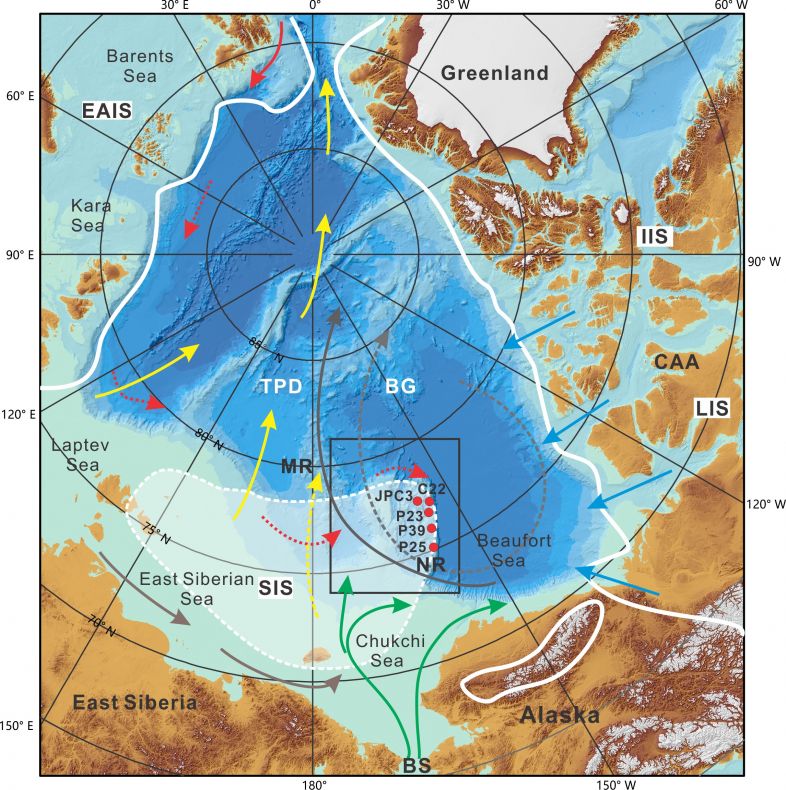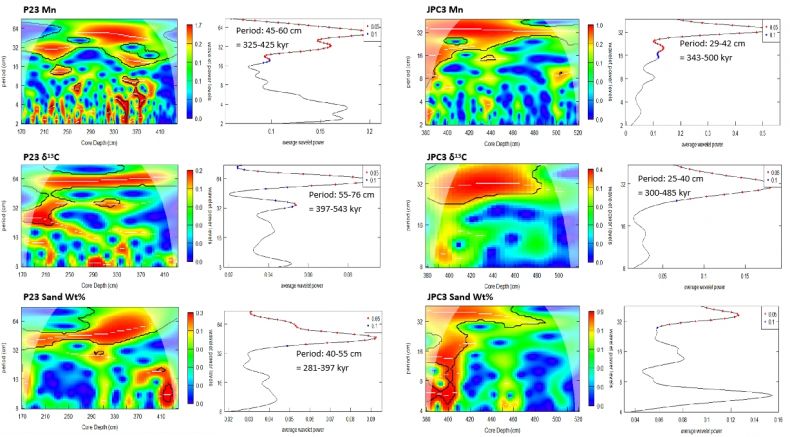The author(s) will give a talk
Cyclic patterns in Quaternary deposits on the Northwind Ridge, western Arctic Ocean: glacial vs. marine signature
1 Ohio State University
2 Ohio State University
3 Second Institute of Oceanography, China
Despite the amplified reaction of the Arctic to climate changes, paleoclimatic cyclicity in sediment records from the Arctic Ocean is poorly understood. Identification of cyclic patterns is complicated by overall low sedimentation rates and poor age constraints, especially in sediments preceding the onset of major Arctic glaciations. We investigate paleoceanographic proxies in sediment cores from the Northwind Ridge, western Arctic Ocean north of Alaska, to identify the dominant long-term cyclicities that affected this part of the Earth during the Quaternary. Based on their proximity to the Laurentide Ice Sheet (LIS) and the depth range encompassing the Atlantic Intermediate Water (AIW) (Fig. 1), these cores are well suited for investigating major paleoclimatic changes. Some of the northernmost cores contain uniquely abundant calcareous microfossils providing material for better age constraints extending to the Early Quaternary and possibly Pliocene, although with large hiatuses (Dipre et al., 2018).
Due to the improved age framework, we recognize for the first time long-eccentricity (~400-kyr) cycles in the Arctic Ocean sedimentary proxies, expressed notably in the visually homogenous pre-glacial deposits (Early Quaternary, ca. 0.8 ? 2.6 Ma) (Fig. 2). After tuning the strongest signal identified in benthic ?13C data to the global records, we attribute these cycles to pulses of intensified AIW circulation, which presumably occurred in pre-glacial times during periods of sea level lowstand and closed Bering Strait. These intervals are characterized by sandier sediment, lower manganese content, and higher ?13C. This cyclicity pattern is consistent with intense ~400-kyr cycles in the monsoonal activity and global ice volume phase-locked to eccentricity forcing in the Pliocene to Early Quaternary (Nie, 2018). The onset of this cyclicity has been related to a change in the ocean circulation due to the Early Pliocene closure of the Panama Seaway. Our data indicate that this change affected the Arctic Ocean, probably by way of an intensified North Atlantic current continuing into the Arctic at mid-depths. At the Mid-Pleistocene Transition this circulation was presumably suppressed by the outflow of meltwater from the expanding Arctic ice sheets.
In contrast to the pre-glacial pattern outlined above, the Middle to Late Quaternary sediments on the Northwind Ridge are predominated by a distinct interlamination of glacial and interglacial-type facies (Dipre et al., 2018; Wang et al., 2021). Furthermore, the variability of proxies changes dramatically with the onset of glacial conditions, e.g., ?13C values get higher in the interglacial intervals corresponding to higher sea levels. This change indicates different paleoclimatic controls on the proxy distribution in the pre-glacial vs. glacially-dominated environments. Preliminary estimates suggest that the leading cyclicities in the Middle-Late Quaternary sediments are in the ~20-100-kyr range, consistent with other Arctic records interpreted to indicate glacial and, possibly, sea-ice controls (e.g., Xiao et al., 2020). However, the obliquity-leaning signal on the Northwind Ridge is more pronounced than in other cores, suggesting a potentially stronger obliquity control on the Arctic LIS margin drained by very large, marine-based ice streams (Fig. 1). Cores with relatively higher sedimentation rates closer to the shelf also show signs of sub-Milankovich variability, possibly reflecting millennial-scale cyclicity in the LIS ice streaming. This pattern, however, could have been asynchronous as indicated by a complex record of glacial provenance proxies (Wang et al., 2021).
Dipre, G.R., Polyak, L., Kuznetsov, A.B., et al., 2018, Plio-Pleistocene sedimentary record from the Northwind Ridge: new insights into paleoclimatic evolution of the western Arctic Ocean for the last 5 Ma: Arktos, v. 4, 24.
Nie J., 2018, The Plio-Pleistocene 405-kyr climate cycles: Palaeogeogaphy., Palaeoclimatology, Palaeoecoogy., v. 510, p. 26–30.
Wang, R., Polyak, L., Zhang, W., 2021, Glacial-interglacial sedimentation and paleocirculation at the Northwind Ridge, western Arctic Ocean: Quaternary Science Reviews, v. 258, 106882.
Xiao, W., Polyak, L., Wang, R., et al., 2020, Middle to late Pleistocene Arctic paleoceanographic changes based on sedimentary records from Mendeleev Ridge and Makarov Basin: Quaternary Science Reviews, v. 228, 106105.

Fig 1.
Index map. Yellow and gray arrows - major surface circulation features: Transpolar Drift (TPD) and Beaufort Gyre (BG) shown in two Arctic Oscillation modes. Red, green, and brown arrows - Atlantic, Pacific, and Siberian Coastal currents. Dotted red arrows - Atlantic Intermediate Water. White outlines show inferred maximum Pleistocene extent of Eurasian (EAIS), Siberian (SIS), Laurentide (LIS), and Innuitian (IIS) ice sheets. Blue arrows - major LIS/IIS ice streams. NR, MR - Northwind and Mendeleev ridges; BS - Bering Strait; CAA - Canadian Arctic Archipelago.

Fig 2.
Wavelet analysis identifies dominant ~400-kyr cycles in the Early Quaternary (ca. 0.8-2.6 Ma) in cores P23 and JPC3: Mn, benthic foraminiferal d13C, and sand content. Cone of Influence is identified by white shading; black contours represent 10% significance level; white lines represent wave ridge. Right panels show the average wavelet power and the periods that are statistically significant at the 0.05 (red dots) and 0.1 (blue dots) levels.